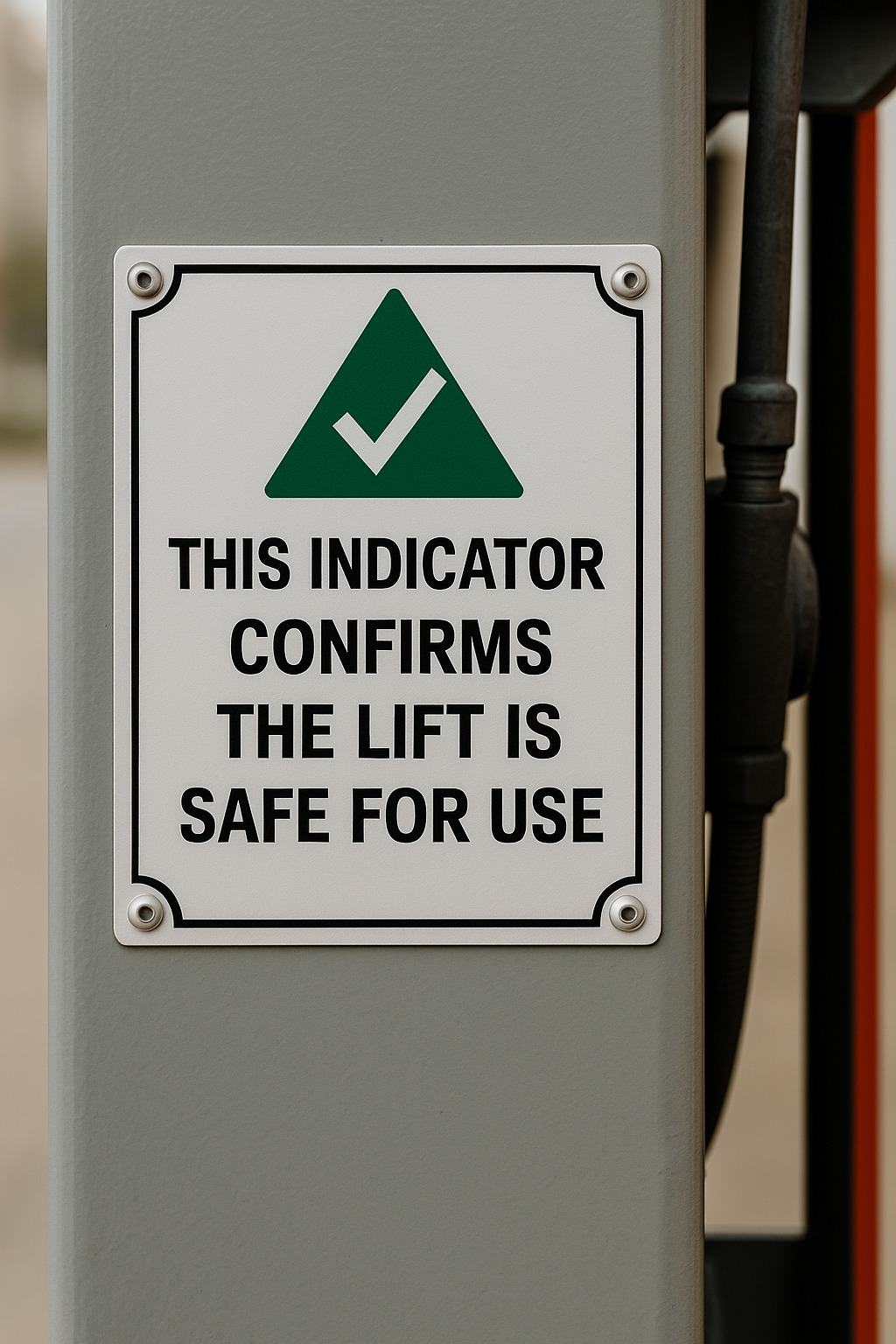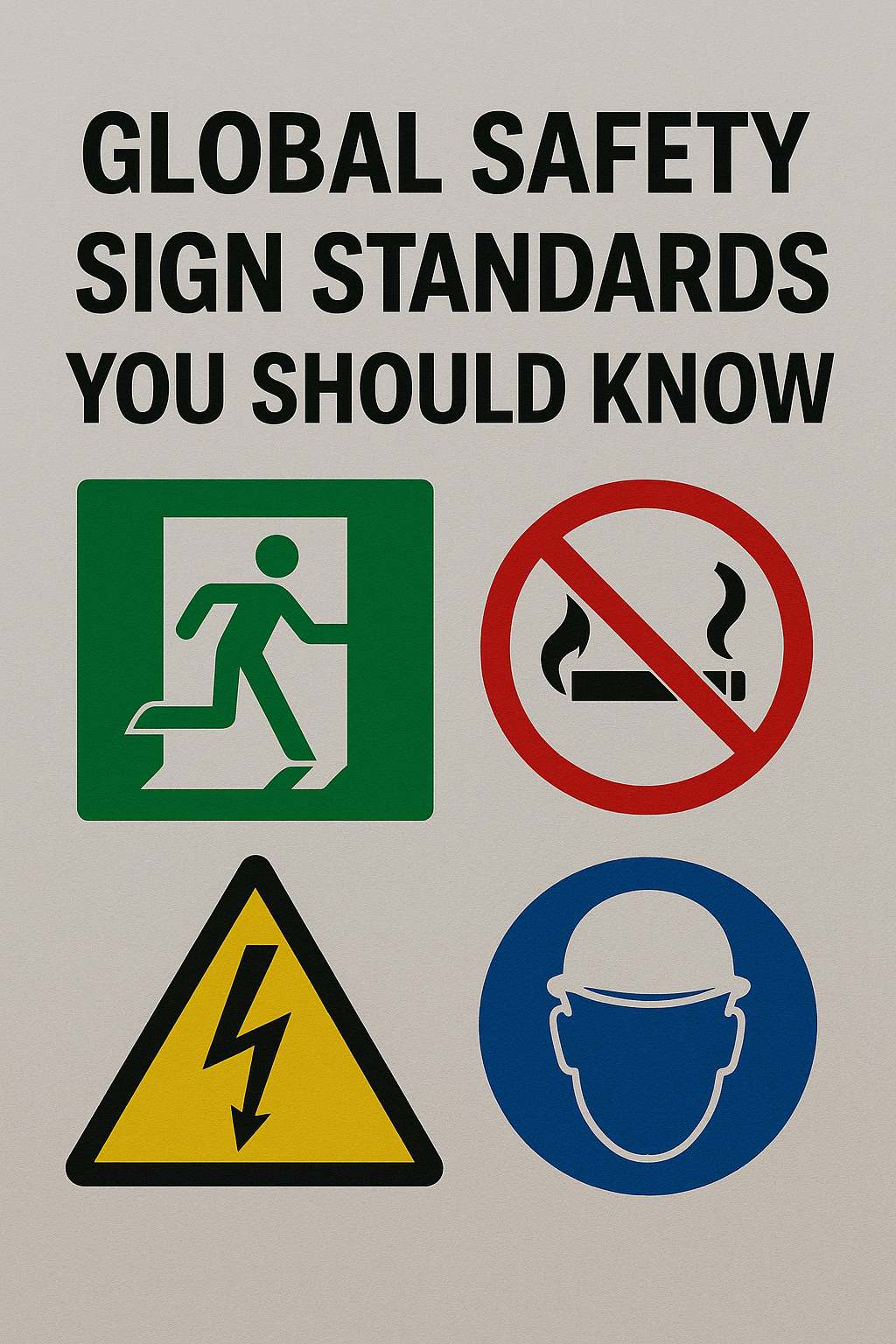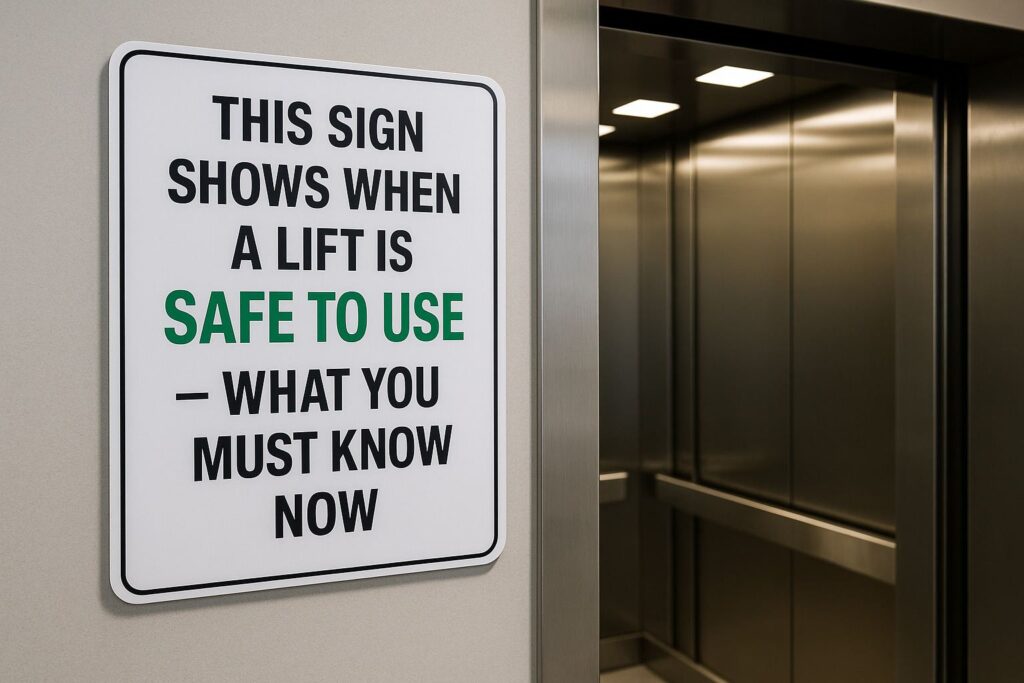In today’s fast-moving world, elevators and lifts are vital to everyday life. Whether in malls, hospitals, or high-rise apartments, we rely on them without thinking twice. But hidden behind their smooth operation is a crucial detail — this sign shows when a lift is safe to use. This sign confirms that all safety systems, including the brake test, control logic system, and door mechanism, are working properly.
Without this small but powerful certification display, people may unknowingly step into danger. A missing or outdated sign means the lift hasn’t passed recent safety checks. It could signal issues like worn mechanical parts, low cable tension, or a faulty emergency bell. Always look for the sign — it’s not just a formality, it’s a life-saving message.
Why Lift Safety Signs Matter More Than Ever
In busy buildings, this sign shows when a lift is safe to use. Without it, lives are at risk. These signs act as silent guardians, confirming inspections are passed and that elevators are ready for use. They help prevent fatal lift accidents caused by mechanical failures, wear and tear, or skipped inspections.
Ignoring lift signage can lead to tragedy. Public awareness of lift safety is still low, especially in older buildings. But with predictive maintenance systems and smart lifts, there’s no excuse. People must understand the importance of visible safety signage and how it helps in avoiding elevator-related accidents.
This indicator confirms the lift is safe for use

This sign shows when a lift is safe to use isn’t just a sticker on the wall. It serves as an official proof that the lift has successfully cleared a safety inspection. It often includes a QR code, inspection date, lift registration number, and sometimes, the AI-driven score.
Understanding lift safety signs means knowing what each item means. From the certified inspector’s name to the inspection expiry, everything must be clear. If these elements are missing or tampered with, it’s a red flag. Identifying valid inspection signs protects you from hidden risks.
What a Valid Lift Safety Sign Looks Like
A true safety sign contains all required data. Look for the inspection certificate, inspection agency, date of last check, and upcoming scheduled inspection. Details like emergency contact, building code, and inspector’s name must be clearly visible.
In modern settings, QR code lift verification connects to a centralized system that updates in real time. Signs must be readable, positioned near the lift control panel, and include multilingual instructions. Faded or outdated signs signal negligence and need reporting.
Inside the Tech That Powers Lift Safety Signs
Modern lift safety signs aren’t simple papers anymore. They’re powered by smart technology, cloud-based inspection systems, and real-time monitoring tools. These digital panels link with remote maintenance servers and alert technicians of faults instantly.
They also use software diagnostics and control logic systems to measure performance. A technician alert goes out if anything fails. Data from hoisting machines, cable tension, brake test, and even door mechanism checks feed into a centralized dashboard.
Load and Structural Endurance Indicators
Safety signs are only issued if structural integrity passes testing. Inspectors look at mechanical parts, support rails, and overload test results. If any component is weakened, the sign won’t be issued. It’s critical for compliance with safety codes.
Brakes, Sensors, and Fail-Safe Testing
Braking systems are tested during each inspection cycle. The alarm system, door sensor calibration, and emergency bell are also checked. These systems ensure a lift doesn’t crash or trap users. Failures here can trigger inspection-based lift restrictions.
Door Locking and Manual Override Checks
Lifts must have secure door mechanisms. Inspectors test for fast closing, manual override, and sensor reactions. Doors that fail auto-reverse or don’t detect obstructions are dangerous. This part plays a big role in how safety signs prevent injury.
Emergency Alerts and Backup Systems
Lifts need working emergency communication tools. The inspector checks for two-way speakers, emergency response speed, and backup power. If emergency protocols fail, the lift won’t get a sign. Emergency signage response must always function.
Smart Logic and Monitoring Protocols
Lifts use digital lift monitoring systems to track safety. They measure traffic, detect unauthorized access, and show a health indicator in real-time. When connected to a centralized dashboard, they flag problems fast and improve the safety review process.
Who Certifies That the Lift Is Safe?
Only a certified authority inspection body can issue a valid sign. These include the municipal authority, third-party agency, or inspection body with trained professionals. These bodies do a full technical audit before approval.
Each country enforces its own set of safety regulations that these authorities must adhere to. For example, ASME in the US or LOLER in the UK. Who approves lift safety? It’s always a certified inspector with legal backing. Without this approval, a sign is invalid.
Missing or Fake Signs: Real-Life Hazards
A missing lift safety sign can hide a dangerous truth. There have been cases where lifts failed because the sign was outdated or forged. This leads to lawsuits and worse. In 2022, a lift collapsed in a mall where the sign was missing during interior remodeling.
The lift had an expired certification, and the facility manager was held accountable.Failing to display proper lift signage can lead to penalties, including hefty fines or even legal prosecution. Lift safety certification is not a formality—it’s lifesaving.
What to Do If the Sign Is Missing
If you notice no sign, act. Do not use the lift. Instead, report it to building management or the maintenance contractor. Many regions have hotlines for report unsafe elevators.
Safe lift use habits include always checking the sign before entering. When not to use a lift? When there’s no visible, legal, updated certificate present. Trust your instincts and avoid risky rides.
Lift Safety Signs and Smart Tech Integration
With smart lifts, safety signs are becoming smarter too. Using digital signage, password authentication, and biometric access, lifts now react in real time to threats. They can shut down if overdue for inspection.
These systems also update signs instantly after inspection. So no waiting, no paper delays. This boosts trust in smart lift systems and enhances lift safety messaging effectiveness. It’s a major leap from old-school signs.
How Often Are Lift Safety Inspections Done?
Inspection timing depends on lift type. Frequency of elevator inspections is yearly for homes. But in malls, hospitals, or towers, it’s every 3–6 months. That includes a full lift inspection checklist.
Each inspection interval covers brake test, door sensor calibration, alarm test, and visual inspection. Some use digital certificate updates to track compliance. Lifts that skip even one inspection log can be dangerous.
Why Building Management Must Enforce Sign Checks
Building owner obligations are clear—they must schedule and enforce sign renewals. A single missed check can void insurance and increase lift hazard. Signs should follow the approved format and remain clearly visible at all times.
Signage enforcement also includes replacing outdated signage or signs with wrong sign placement. The facility manager should oversee checks, verify the inspection system, and log results in a maintenance log.
Global Safety Sign Standards You Should Know

Countries use different standards. In Japan, signs feature pictograms and characters. Meanwhile, Germany incorporates two languages and includes details such as certification procedures. This approach ensures clarity for both locals and international users.
In Pakistan and India, visual design is key due to low literacy. Visual assurance and hazard communication are vital. Uniformity helps users trust what they see. That’s why global rules matter for user response to lift signage.
Raise Awareness: Help Prevent Lift Accidents
Educational elevator safety campaigns teach people what to check. Flyers, videos, and public education events inform users of their rights. They explain how to read a lift sign, spot fraud, and know what lift safety signs mean.
Awareness of inspection certificates must improve. People should know the law on elevator inspection and report violations. Creating this culture helps reduce lift failure due to inspection lapse and saves lives.
Final Thoughts: Don’t Ignore the Sign That Saves Lives
In every building with elevator systems, the certification display known as “this sign shows when a lift is safe to use” stands as the final checkpoint between safety and catastrophe. This small placard isn’t just an afterthought; it’s the output of technical inspections, legal approvals, and regulatory compliance. From checking brake tests, cable tension, and door mechanism to analyzing software via control logic systems, every part of a lift’s function must pass scrutiny before the sign is granted. Without it, the lift is a ticking hazard.
Building management, facility managers, and maintenance contractors carry the burden of ensuring these signs are up-to-date. Delays in inspections, ignored inspection expiry dates, or overlooked safety signage can lead to fatal lift accidents, legal trouble, and even loss of lives. The emergence of smart lifts, digital signage, and AI-driven score systems offers a proactive edge in safety. Yet, technology is only as effective as the humans who enforce its standards. By promoting public awareness of lift safety and fostering a culture of responsibility, we reduce the chance of tragedies and make vertical transport safe for all.
Frequently Asked Questions (FAQs)
1. What Makes a Lift Sign Trustworthy and Legal?
A trustworthy lift sign must include the inspection certificate, certified inspector’s name, inspection date, and inspection expiry. It should follow building code enforcement and show proof of inspection from a certified authority inspection body. QR code lift verification is a modern way to check if it’s real or fake.
2. Who’s Responsible for Lift Safety Sign Updates?
Updating lift safety signs is the duty of building management or the designated facility supervisor. They must ensure the lift gets inspected on time and that the certification display is renewed, visible, and legal. Delays can lead to legal consequences of missing signage or even lift shutdowns.
3. Can You Ride a Lift Without a Safety Sign?
No. When not to use a lift is clear: never use one if the sign is missing, expired, or unreadable. It may conceal issues like equipment damage, malfunctioning components, or potential security threats. Riding such lifts increases the chance of fatal lift accidents or elevator safety phobia.
4. Is Digital Lift Signage Safe and Reliable?
Yes. Digital lift monitoring systems use cloud-based inspection systems, real-time lift safety info, and AI-driven score updates. They’re harder to fake and update immediately after inspections. With password authentication, biometric access, and technician alert, they boost trust in smart lift systems.
5. How Can I Tell If a Lift Sign Is Outdated or Fake?
Check the expiration date on the inspection and verify it through the QR-enabled safety sign. Outdated lift certificate dates, blurry text, or poor signage placement are red flags. You can also report it if it doesn’t match known signage format or the authorized inspector’s credentials are missing.
6. Why Do Lift Inspections Happen So Often?
Frequency of elevator inspections depends on usage. Residential lifts are inspected once a year. Commercial places like malls or hospitals undergo scheduled inspection every 3–6 months. This keeps emergency preparedness, control system, and alarm test functions in check.
7. Are Smart Lifts Safer Than Traditional Ones?
Smart lifts offer predictive safety using software diagnostics and real-time monitoring. They auto-update signs, detect faults, and prevent inspection-based lift restrictions. Though they need strong cybersecurity, smart lifts reduce human error and support proactive safety signage updates.
8. What Happens If the Sign Is Missing or Broken?
If there’s a missing lift safety sign, report it immediately. Don’t use the lift. Notify the inspection agency, building management, or municipal authority. Continuing use can lead to lift failure due to inspection lapse and legal trouble for the owner.
ALSO READ:
Fintechzoom.com CAC 40 Surge: Expert Forecasts & Hot Trends
Your Topics Multiple Stories: Dominate Google Rankings Now
Candizi: Guilt-Free Candy That Tastes Too Good to Be True

